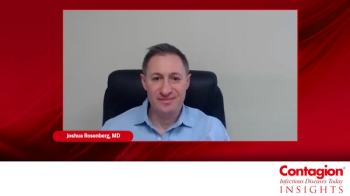
The NanoVax Vaccine Platform: Pandemic Preparedness and the Role of Mucosal Immunity
Chad Costley, MD, MPH, discussed the platform's ability to respond to emerging respiratory diseases and the challenges in advancing mucosal vaccine development for health preparedness.
In the second part of our recent interview, Chad Costley, MD, MPH, president and CEO of BlueWillow Biologics, discussed the NanoVax intranasal adjuvant vaccine for avian flu (H5N1), starting with its potential role in pandemic preparedness. He explained how the platform could be adapted to address a range of respiratory diseases, from seasonal flu to future pandemic threats, and highlighted the role of mucosal immunity in vaccine development, along with the challenges of evaluating these vaccines for future use.
When discussing future pandemic preparedness, he said, “I think the phrase 'disease X' comes up, with 'X' obviously meaning we don’t really know where the next pandemic is coming from. Obviously, there are certain places where it’s more likely to come from. I think influenza probably leads that list, whether it be pandemic flu, or a seasonal flu virus that’s very different from previous strains. COVID is another example. So, you really need a platform that addresses all of these kinds of respiratory diseases.”
Costley explained that BlueWillow’s platform is suited for rapid response to emerging diseases because of its flexibility in incorporating a wide range of antigens. He elaborated on the technology’s potential, “What our platform does, because it’s so flexible in terms of the antigens it can incorporate, is it sets us up to very quickly respond if the world can make the antigen specific to the disease that’s emerging. With AI technologies and other advancements, we can make recombinant proteins much more quickly than we used to. So, the gap between how quickly you can make, say, an mRNA vaccine with the genetic code and a recombinant protein is closing.”
Costley further emphasized how this platform could be deployed as part of global pandemic preparedness efforts. He pointed out its practical advantages, particularly for stockpiling and rapid deployment in resource-limited regions, “It could be pre-positioned in areas of need—third-world countries, WHO, CEPI, organizations focused on these issues, the Gates Foundation. These organizations could hold it as a stockpile, ready to go as soon as the proteins are available. It’s very stable, it doesn’t require a cold chain. Obviously, it’s oil and water, so you can’t freeze it and you can’t boil it. But other than that, if you keep it at two to eight degrees Celsius, it’s stable for years. It’s inexpensive to make and not complicated to manufacture. So it really checks a lot of those boxes for preparedness. It’s compatible with multiple antigens.” The cost-effectiveness and simplicity of production make the NanoVax platform a potential vaccine for global health initiatives, particularly in low-resource settings.
One area in vaccine research today is the growing focus on mucosal immunity, which plays a role in the body’s defense against respiratory infections. Costley noted that the scientific community has recognized the importance of mucosal vaccines, a shift that reflects a broader understanding of how immune responses work in the respiratory system.
“It’s exciting to see the increased attention in mucosal immunity,” Costley said. “I think the scientific community has really come around on that. If you were at one of these conferences 10 years ago, you wouldn’t have heard much about it. There might have been some nasal vaccines in the background, maybe an occasional oral vaccine. There was some stuff out there, but now, it is a major area of focus. People really understand the importance of mucosal immunity, especially in the case of influenza.”
While mucosal vaccines show potential, Costley acknowledged the challenges in developing these types of vaccines, he said, “There are also real challenges that I think need to be addressed, and one of them is that we don’t have what are known as 'correlates of protection' for mucosal vaccines,” Costley explained. “We can create certain immune responses, whether it’s an immunoglobulin response in the nose or a certain immune response in the blood, that’s not HAI (hemagglutination inhibition), which is the standard scoring for seasonal flu vaccines today, and mucosal vaccines don’t really focus on that approach.”
Costley discussed that to fully realize the potential of mucosal vaccines, a new framework for evaluating their efficacy must be developed, “We need a different scorecard, and that’s a real challenge. It will require private partnerships with public agencies, and it will involve FDA forward-thinking. I think the FDA is very focused on this, but we need a way to score vaccines that aren’t traditional vaccines.”
Despite these challenges, Costley expressed optimism about the potential of mucosal vaccines and their role in improving public health outcomes, “I believe that with investment, innovation, and collaboration, we’ll overcome these challenges and ultimately be better prepared for future pandemics.”
Reference
BlueWillow Biologics to Present Significant Progress on Its Novel Intranasal Vaccine Technology at World Vaccine Congress Europe. Biospace. October 28, 2024. Accessed November 13, 2024. https://www.biospace.com/press-releases/bluewillow-biologics-to-present-significant-progress-on-its-novel-intranasal-vaccine-technology-at-world-vaccine-congress-europe
Newsletter
Stay ahead of emerging infectious disease threats with expert insights and breaking research. Subscribe now to get updates delivered straight to your inbox.






























































































































































































































































































































